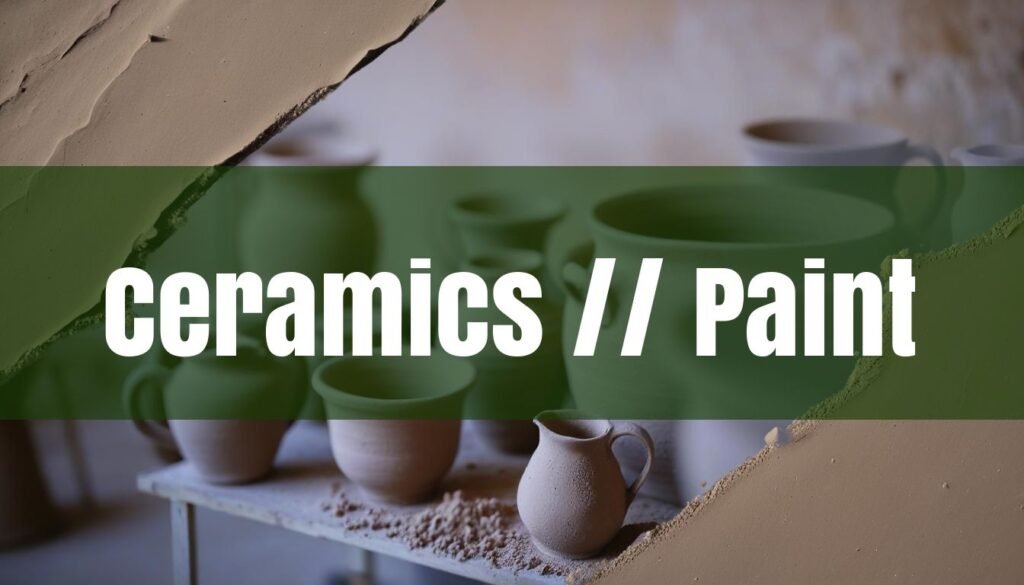Painting ceramics at home offers a wonderful opportunity to explore your creativity, relax, and produce unique, personalized pieces. Whether you’re looking to create a custom mug, a decorative plate, or a charming figurine, the process is accessible and enjoyable. This article will guide you through the various avenues for acquiring ceramics to paint at home, the best types of paints to use, essential techniques, and how to ensure your finished artwork lasts.
Finding Your Canvas: Where to Buy Ceramics for Painting
The quest for the perfect ceramic piece to paint begins with knowing where to look. Several options are available, each with its own advantages. Online marketplaces like Amazon and Etsy provide a vast selection of unglazed ceramic items ready for painting. These platforms offer convenience, allowing you to browse from the comfort of your home, compare prices, and read reviews. However, keep in mind that shipping costs can sometimes be a factor, and it’s essential to check the seller’s reputation to ensure quality.
For a more hands-on experience, consider visiting a local “paint-your-own-pottery” studio. Many of these studios offer take-home kits that include a ceramic piece, paints, brushes, and instructions. This option is perfect for those who appreciate supporting local businesses and receiving personalized advice. Craft stores like Michaels and Hobby Lobby are also excellent resources, stocking a variety of ceramic pieces, paints, and other necessary supplies. These stores often have sales and coupons, making them a budget-friendly choice. For those seeking a wider variety of ceramic forms or planning larger projects, pottery supply stores are a great option. These stores typically sell bisque, which is ceramic ware that has been fired once but not yet glazed. Bisque is available in numerous shapes and sizes, and purchasing in bulk can often result in lower prices. However, this option may require some prior knowledge of ceramics and painting techniques. Pottery 101: A Beginner’s Guide might be useful if you’re just starting out. Painted Color Ceramics is also a great option, all their items are fired to an 03/04 for Glaze or Non Fired Acrylic use.
Choosing the Right Materials: Ceramics and Paints
Selecting the right type of ceramic and paint is crucial for a successful painting project. For beginners, unglazed ceramics are the most user-friendly, as they provide a porous surface that readily accepts paint. Three common types of clay used in ceramics are stoneware, earthenware, and porcelain. Stoneware is versatile and easy to work with, making it ideal for beginners. Once fired, it’s non-porous and can hold liquids without glazing. Earthenware is thicker and heavier than stoneware but also easy to work with, but it needs to be glazed to be permeable. Porcelain is more challenging to shape and requires more experience.
When it comes to paints, acrylics are a popular choice for painting unglazed ceramics because they are convenient, easy to find, non-toxic, and fast-drying. However, for glazed ceramics, porcelain paint is recommended as it adheres better to the surface. Porcelain paint can be baked in a conventional oven to set the paint and make it waterproof and washable. Other options include enamel, an oil-based paint known for its durability and glossy finish, and latex, a water-based paint that requires multiple coats for a solid finish. Decola is a highly-rated brand for ceramic paint, offering pigment-dense paints specifically designed for ceramics and glass.
Essential Techniques and Tools for Ceramic Painting
Beyond the ceramic piece and paints, a few essential tools and techniques can elevate your painting experience. Brushes are essential and come in various shapes and sizes, each suited for different purposes. Flat-tipped brushes are ideal for shading and geometric work, while fine-tipped brushes are perfect for intricate details. Other useful tools include palettes for mixing paints, sponges for creating textures and cleaning surfaces, stencils for precise designs, and banding wheels for easily rotating the ceramic piece while painting.
Several painting techniques can add depth and interest to your ceramic pieces. Shading involves using light and dark colors to create depth and dimension. Layering colors allows you to build opacity and create richer, more saturated hues. Blending colors together, especially for an ombre effect, adds a seamless transition between shades. Texturing techniques, such as marbling or creating scales, can add visual interest and a unique touch to your pottery. For more on this, read Pottery Textures: Stamps and More.
Sealing and Firing for Longevity
To ensure the longevity and durability of your painted ceramics, proper sealing or firing is essential. If you’re using acrylic paints on unglazed ceramics, applying a sealant or varnish will protect the painted surface from chipping and scratching. Duncan spray and brush-on sealers are a popular choice, offering both gloss and matte finishes. For ceramics painted with porcelain paint, baking in a conventional oven is recommended. Follow the paint manufacturer’s instructions for baking times and temperatures to ensure the paint sets properly and becomes waterproof and dishwasher-safe.
For those interested in firing their ceramics at higher temperatures, a kiln is necessary. However, alternative firing methods, such as Raku firing and pit firing, can be explored, although they require a well-ventilated outdoor space and careful attention to safety precautions. Keep in mind that not all paints are food-safe, so if you’re painting items intended for food use, be sure to use paints specifically labeled as such and follow the manufacturer’s instructions for sealing or firing.





